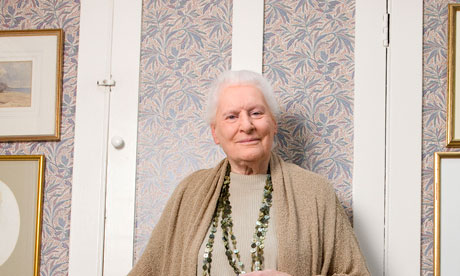Mark Vernon chairs a discussion with two leading experts on Jung, each offering a different perspective: Robert Rowland-Smith, philosopher, consultant, columnist and author and Gary Lachman; author of Jung The Mystic and bass-player and composer in a band called Blondie.
Listen to the full audio
Download the video (mp4)
Watch Carl Jung - Legacy and Influence on our YouTube Channel
Watch Carl Jung - Legacy and Influence on our Vimeo Channel
Since we are talking about Jung, here are two recent articles on his theory of synchronicity, one of which, the first one, is by Mark Vernon.
Carl Jung, part 6: Synchronicity
With physicist Wolfgang Pauli, Jung explored the link between the disparate realities of matter and mind
Mark Vernon Diana Athill's experience of 'synchroncity' inspired a short story. Photograph: Karen Robinson
Diana Athill's experience of 'synchroncity' inspired a short story. Photograph: Karen RobinsonThe literary agent and author Diane Athill describes the genesis of one of her short stories. It occurred about nine one morning, when she was walking her dog. Crossing the road, a car approached and slowed down. She presumed someone needed directions. A man leaned out and brazenly asked her whether she would like to join him for coffee.
That was odd enough, so early in the day. More oddly still, the man powerfully reminded her of someone else. He looked just like a lost friend and, further, the daring approach was just the kind of thing her friend would have done. She couldn't stop thinking about the coincidence. It left her feeling " energised and strange", a flow that kept bubbling up until she channelled it, producing the short story.
It is an example of what Jung called synchronicity, "a coincidence in time of two or more causally unrelated events which have the same or similar meaning" – in Athill's case, the surprising invitation of the man and his looking like her friend. Anecdotally, it seems that such experiences are familiar to many. They are undoubtedly meaningful and produce tangible effects too, like short stories. But they raise a question: is the relationship between the events random or is some hidden force actively at work?
Jung pursued this question in an odd relationship of his own, with one of the great physicists of the 20th century, Wolfgang Pauli. The story of their friendship is related by Arthur I Miller, in 137: Jung, Pauli and the Pursuit of a Scientific Obsession.
Pauli was a Jekyll and Hyde character, a Nobel theorist by day and sometime drunk womaniser by night. He turned to Jung when he could no longer hold the competing aspects of his life together. Jung was always fascinated by personality splits, and his analysis helped to steady Pauli. They began working together in a collaboration that lasted for several decades, though mostly behind closed doors: Pauli worried for his reputation, though eventually they published a book together.
Miller demonstrates that Jung provided insights which facilitated Pauli with his great contributions to science, notably the exclusion principle that bears his name, a linchpin of quantum physics. It required the introduction of a fourth quantum number, a highly counterintuitive move as the new quantum number represents nothing that can be visualised. However, it made sense in Jung's archetypal conception of things because a three becoming a four, the symbol of quaternity, represents a state of greater wholeness than a trinity. He had gathered instances of the same move across a range of human activities, from geometry to theology.
What interested Jung was not so much the brilliance of Pauli's discoveries, but the nature of the intuition that inspired them. He could be said to have concluded that a conceptual leap forward occurs when an archetype constellates, that is to say when an implicit potentiality – in this case the quaternity – is instantiated in a solution to the problem concerned. That an archetypal force is at work, and not just an inspired guess, was suggested to Jung by the feeling of exhilaration occasioned by the discovery. The sense is not just of a problem solved, but of reality revealed.
It is for similar reasons that qualities like beauty and simplicity, synthesis and complementarity seem to hold the key to the discovery of truths, and hence are important guides when probing the mysteries of nature. The striking element is that such qualities have a profound subjective appeal and produce verifiable objective results.
Jung and Pauli conjectured that they were dealing with a link between the apparently disparate realities of matter and mind. Jung objected to the dualism implied by suggesting these two aspects are distinct kinds of stuff, and so sought a unitary dimension beneath the dualism. In this, he is far from unusual: philosophers and mystics alike have discerned what Jung called the unus mundus or unitary world.
Archetypes, as implicit structuring principles, provide a way of conceptualising the common ground shared by mind and matter.
Pauli called it a "missing link", though he was also very aware of the accusation of providing mystification rather than explanation. "In my own view it is only a narrow passage of truth (no matter whether scientific or other truth) that passes between the Scylla of a blue fog of mysticism and the Charybdis of a sterile rationalism," he observed. "This will always be full of pitfalls and one can fall down on both sides."
Individuals from Plato to Spinoza have similarly tried to chart that fine course. However, apart from the breakthroughs such intuitions produced, Pauli had reason to trust that the world was odder than he might otherwise think.
He was well known for being present when machines and equipment broke. So common were such failures that his colleagues wittily talked of the Pauli effect. They would even jest as to whether Pauli had been nearby when apparatus didn't work, reporting many instances when it turned out he was.
Sceptics would no doubt ask that Pauli be placed in a lab and the effect tested for statistical significance. But what that misses is the key feature of phenomena like the Pauli effect, and synchronicity. They are random. They are beyond anyone's direct control – for all that some charlatans have claimed voluntarily to bend spoons, crack mirrors and the like. So, lab tests will inevitably miss what they seek to verify.
How, then, to decide whether random things happen that are then interpreted as meaningful, or whether things happen that are not only meaningful but can't be mere coincidence? Pauli and Jung mulled over the distinction. Miller reports that Pauli inclined to the former view, Jung the latter. However, both agreed that evidence won't resolve the difference because meaningful coincidences can't be studied statistically.
They are rare as events. They are big as experiences. And luckily for modern physics, Pauli chose to take them seriously. Luckily for modern literature, Diana Athill did so too.
This one comes from
Read the whole post.Synchronicity
Carl Jung coined the term "synchronicity". It means that somehow, we are all immediately connected. That would mean that somehow, we all feel the same and know the same, when it passes through us like time and things happening in the moment. That would apply to all of culture, with all its imperfections and anomalies, but also with all its brilliant solutions and inspirations. It also means that culture, society and community, can be as one and develop as one.
Constructive recollection can also describe or even explain, how culture, society and community develop as one. The oneness would especially be specified by the being as equal as possible, of sensing and knowing, their only difference being material (sensing material reality) or immaterial (knowing cultural reality), while time and place would always be the same. Sensing and knowing are basic to three levels above them, leading up to (social) action and (social) reaction.

No comments:
Post a Comment